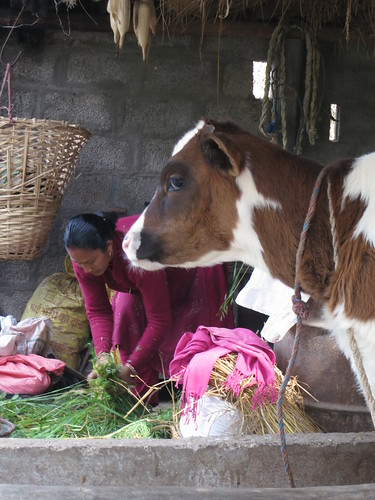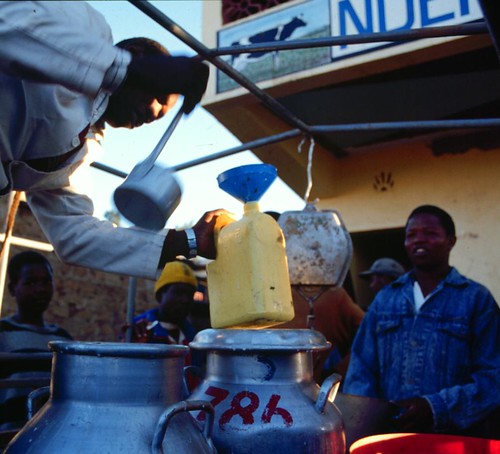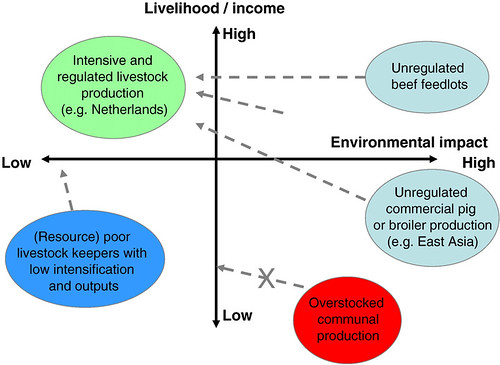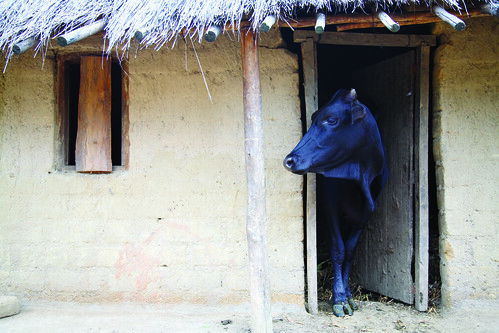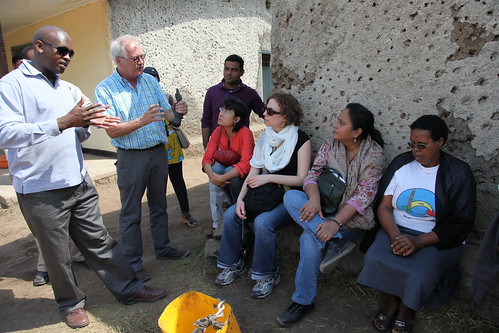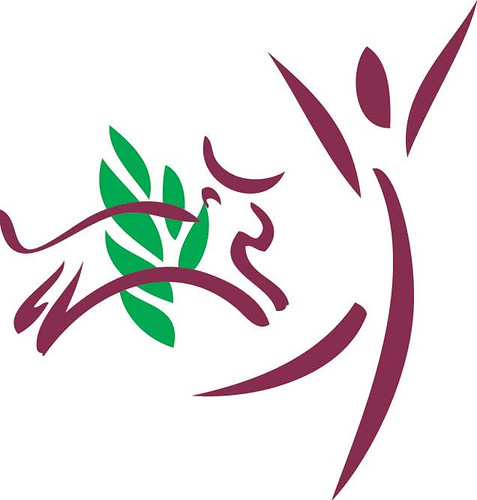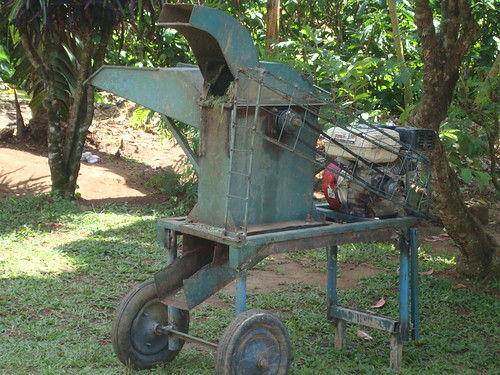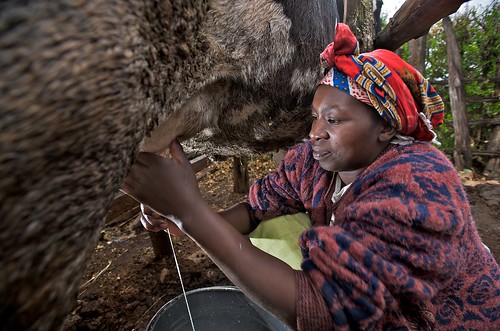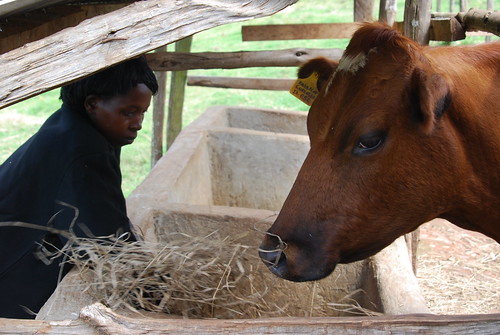Dairy woman Nimala Bogati feeds her improved dairy cows green fodder. An ILRI-CSISA project on the Indo-Gangetic Plains of Chitwan District, in south-central Nepal, began in Sep 2010. Project staff are introducing residue-based feeding strategies supplemented with green fodder and concentrates to increase cattle and buffalo milk production (photo credit: ILRI/Susan MacMillan).
Starting in 2010, feed‐related aspects of dairying in two municipalities of Chitwan District in south-central Nepal have been investigated by staff members from the International Livestock Research Institute (ILRI) and a local Nepali non-governmental organization called Forum for Rural Welfare and Agricultural Reform for Development (FORWARD). This study set out to gain an understanding of the overall dairy production system in this district, with a particular focus on the livestock feeding strategies employed by farmers, and to identify key areas of the feeding strategy that could be altered to improve livestock productivity. A feed assessment tool called FEAST—a questionnaire that combines informal group discussions with structured interviews of key farmer informants—was used to rapidly assess on‐farm feed availability in a smallholder context.
FORWARD’s Deep Sapkota and ILRI’s Arindam Samaddar confer on a visit to a smallholder dairy producer in Gitanagar, Chitwan District, south-central Nepal (photo credit: ILRI/Susan MacMillan).
Project staff from ILRI and FORWARD selected the municipalities of Gitanagar and Ratnanagar for this study because these sites were to become part of projects conducted by a multi-institutional Cereal Systems Initiative of South Asia (CSISA) in Nepal.
Farmers in this area generally have very small plots of land, averaging just 0.24 hectares, from which they produce a wide variety of crops. Rice, maize and wheat are the dominant cereal crops here. Goats and dairy cattle, predominately Holstein-Friesian and Jersey, are the main livestock kept. Some households also keep dairy buffaloes and poultry.
Dairying and other livestock activities contribute 63% of household income, cropping the remaining 37%.
Crop residues (most of which until recently were purchased) are the primary component of the feed for the farm animals and are relied on throughout the year.
Purchased concentrate feeds such as wheat bran and commercially mixed rations provide a significant portion of the dietary metabolizable energy and crude protein.
ILRI has been working with FORWARD for just over one year to improve understanding in these farming communities of key animal health, nutrition and reproduction concepts, so that the farmers can reduce the costs of their milk production, with purchased feed being the main cost.
Two goats kept by a farm household in Nepal in a community served by the ILRI-FORWARD-CSISA project (photo credit: ILRI/Susan MacMillan).
Goats are the most popular livestock species kept within the area. Eighty percent of households keep 2–3 goats, which are used to fulfil household meat requirements and/or sold at irregular intervals for slaughter. Half the households here keep improved dairy cows, primarily Holstein-Freisian and Jersey, with each household keeping some 2–3 cows. About 10% of the households maintain local buffalo, and 5% improved buffalo such as Murrah, for milking, with each household keeping 1–2 animals. Local cows and buffalo are the cheapest dairy animals available, costing about 10,000Rs (USD$141) and 30,000Rs (USD$423) per head respectively. Improved cows and buffalo are available for 80000–90000Rs (USD$1128–USD$1269) per head. Dairy animals in this area produce approximately 3141 litres of milk per head per year, with sales of milk generating 249446Rs (USD$3519) per household annually.
Bhim Bahadur Bogati, father-in-law of dairy woman Nirmala Bogati, and his son’s staff-kept buffalo cow (photo credit: ILRI/Susan MacMillan).
The dairy animals are usually maintained in purpose built sheds in close proximity to the household and stall fed throughout the year. The shed will generally only have temporary walls that are erected during winter months to keep the animals warm. During summer months, the walls are removed to allow air to circulate around the animals to keep them cool.
To find out more, read: Characterisation of the livestock production system and the potential of feed‐based interventions in the municipality of Ratnanagar and Gitanagar in the Chitwan district of southern Nepal, September 2010.
Notes
About FEAST
Feed for livestock is often cited as the main constraint to improved productivity in smallholder systems. Overcoming this constraint often seems an elusive goal and technical feed interventions tend to adopt a scattergun or trial and error approach which often fails to adequately diagnose the nature of the feed problem and opportunities and therefore the means to deal with problems and harness opportunities. The purpose of the Feed Assessment Tool described here is to offer a systematic and rapid methodology for assessing feed resources at site level with a view to developing a site-specific strategy for improving feed supply and utilization through technical or organizational interventions. Output from FEAST consists of a short report in a defined format along with some quantitative information on overall feed availability, quality and seasonality which can be used to help inform intervention strategies. The tool is aimed at research and development practitioners who are working in the livestock sector and need a more systematic means of assessing current feed-related strategies and developing new ones.
About CSISA
The Cereal Systems Initiative for South Asia (CSISA) applies science and technologies to accelerate cereal production growth in South Asia’s most important grain baskets. CSISA works in partnerships in 9 intensive cereal-production ‘hubs’ in Bangladesh, India, Nepal and Pakistan to boost deployment of existing crop varieties, hybrids, management technologies and market information. CSISA is funded by the Bill and Melinda Gates Foundation and the United States Agency for International Development and conducted by the International Maize and Wheat Improvement Program (CIMMYT), the International Food Policy Research Institute (IFPRI), ILRI and the International Rice Research Institute (IRRI).
ILRI DAIRY FEED INTERVENTIONS IN SOUTH ASIA
Last September, ILRI held a workshop in Dehradun, northern India, to develop a tool for feed technology screening and prioritization. Last December, ILRI and national research institutions and NGOs from Bangladesh, India and Nepal conducted dairy feed experimental trials and demonstrated better use of crop residues for feeding to their dairy cows. Thirteen participants from four sites in Haryana, India (National Dairy Research Institute); Bihar, India (Bihar Veterinary College, Sarairanjan Primary Agricultural Cooperative Society); Chitwan, Nepal (Forum for Rural Welfare and Agricultural Reform for Development); and Dinajpur, Bangladesh (Bangladesh Livestock Research Institute, Cooperative for Assistance and Relief Everywhere) shared their results of the feed intervention trials and related training activities.
ETHIOPIAN LIVESTOCK FEEDS PROJECT (ELF)
This week (21–22 Feb 2012), an inception workshop for an Ethiopian Livestock Feeds Project (ELF) is taking place at ILRI’s campus in Addis Ababa, Ethiopia. The project involves a short scoping study that will be used to help further develop and test rapid livestock feed assessment methods such as FEAST and Techfit. This work is funded by the Australian Centre for International Agricultural Research.

